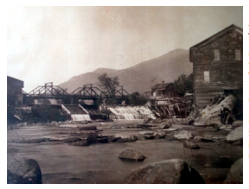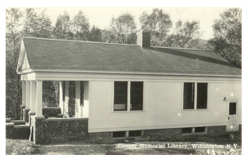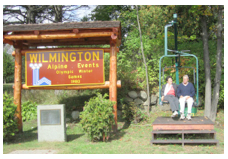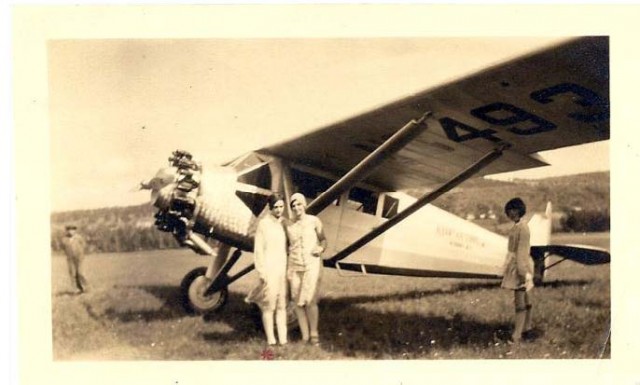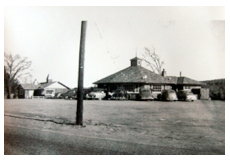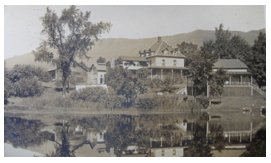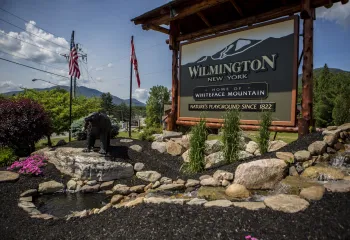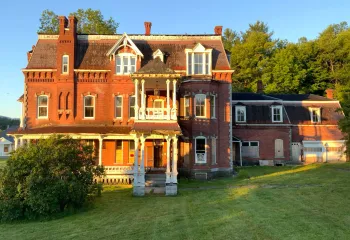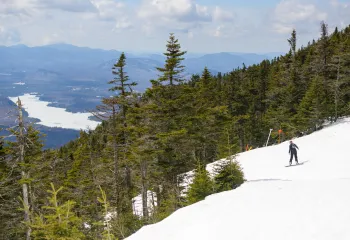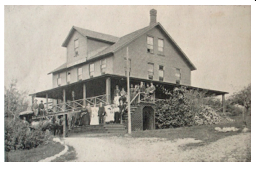
Walk through history
The Town of Wilmington was founded nearly 200 years ago by hardy pioneers from New England, searching for land and a self-sufficient way of life. Once an obscure farming village on the banks of the Ausable River, its earliest industries were grist milling and distillation of whiskey from the grain fields. Since then, Wilmington has evolved into an outdoor recreation mecca! This Wilmington Historical Walking Tour will give you an idea how time and conditions have changed the complexion of the town.
A look at the current Wilmington Bridge and Dam – (a good photo op!)
Prior to 1881, this same vantage point would have given you the view in the photo to the left. In the early 1800's people settled in Wilmington because of its proximity to the mechanical water power of the Ausable River and because of the nearby resources of lumber and iron ore.
The photo shows a sawmill on the left of the bridge, a damaged sawmill on the right of the bridge, and a grist mill on the right in the foreground. The bridge is a wooden bridge and the dam was much closer to the bridge than it is now.
On either side of the Ausable River, early settlers took advantage of the river for mechanical power for making agricultural and industrial products and for flood controls. The occupations in the surrounding area included farming, mining, lumbering and charcoaling. The industries on the river expanded as follows:
Ca.1800--- Leonard Owen builds the first grist mill, and likely the accompanying mill
pond dam.
Ca. 1812--- Reuben Sanford builds a wooden dam for mechanical water power for an
iron forge, potash factory, starch factory, grist mills and saw mills.
Ca. 1850--- Other industrialists take over the forge, factories, and mills, including
Weston & Nye, James Bliss, and Monroe Hall.
As the iron industry moved out to Minnesota and other more western states in the later 1800's, Wilmington's industrial-based economy was slowly replaced by a tourism-based economy. An iron bridge replaced this wooden one after 1881, which in turn was replaced by the current stone bridge in 1934.
Wilmington E.M. Cooper Memorial Library (& former sawmill site)
Ellison Minor Cooper, born in Wilmington in 1854, had left this area becoming a prominent successful businessman in Philadelphia, PA. Near the end of his life, as his health was beginning to fail, he decided to leave a legacy in the form of a public library to be built in his boyhood home of Wilmington, along with a substantial bequest to support the library in his Will. The Cooper Memorial Library Association was formed on August 20,1918 with Mr. Cooper present. He began by donating between 5,000 and 6,000 books. Until a building could be constructed, the library was temporarily housed in the Methodist Church lower level that had a south-side entry of its own. E.M. Cooper died at his home in Philadelphia in September 1920. The new library building was completed in 1934 on the site of one of the former sawmills. Photo ca. 1934
Wilmington Dam Dedication Plaque & 1980 Winter Olympics Sign & chairlift (another great photo op!)
While there has been a dam in this approximate location since about 1810, the current Wilmington Dam was constructed in 1938 with major renovations & reconstruction done in 2003 and 2004. The first purposes of the dam, from 1810-1870's, were for mechanical power for making agricultural and industrial products and flood controls. In 1878, part of the wooden dam broke, damaging some mills and property. The dam and mills were repaired, but a new era was dawning with the natural beauty of the area becoming popular with the new idea of "vacationing" in the healthful Adirondack Mountains. Local hotel owners Weston, and later F.E. Everest, began publicizing the recreational opportunities of the Ausable River in Wilmington. In 1920, Frank E. Everest built a power generation system to supply his Whiteface Mountain House (hotel) and other properties with electricity. On March 1936, the spring thaw and large blocks of ice destroyed the dam. By 1938, a new dam which was built for the purposes of recreation, the potential for electrical power generation, and flood controls. At this last dam era, the shift from Wilmington's economic base of mills and industry to tourism had taken place.
Wilmington was the site of the 1980 Winter Olympics Alpine events held at Whiteface Mountain Ski Center. The current Ski Center site opened in 1957, having relocated from its original site on the Marble Mountain side of Whiteface, which had been developed in the post WWII era. It is comprised of approximately 283 skiable acres of land with 86 ski trails and the greatest vertical drop in the east at 3,430 feet. In 1980 there was a bad snow drought, the worst since 1887, but because of a new snowmaking system, Whiteface was able to make a man-made snow cover which had never before been used in Olympic Games competitions. Among the well-known competitors at the time were Swedish Olympian Ingemar Stenmark who took gold on both the men's slalom & giant slalom, American Phil Mahre who took silver in the slalom, and Liechtenstein's Hanni Wenzel who took silver in women's downhill, and gold in both women's slalom and giant slalom. Whiteface Mountain Ski Center currently hosts many World Cup competitions and has many times been voted the #1 ski resort by Ski Magazine.
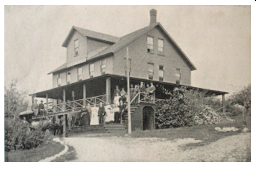
Bliss House (hotel site, currently a different private home is located on the same site)
The Bliss House (hotel) was a popular stage stop on the route from Ausable Chasm to Lake Placid in the late 1800's. It advertised the freshest food, good water, telephone & telegraph connection, a first class livery, good saddle horses, fine baseball grounds and tennis court. It also offered a direct route to the top of Whiteface Mountain on a bridle trail so that horses could be ridden to the top of the mountain.
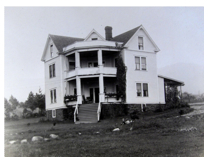
Bliss Farm (now a private residence)
The Bliss Farm was constructed in approximately 1890. While the farm supplied fresh milk , butter & eggs to the Bliss House (hotel), it also accommodated tourists with rooms & meals.
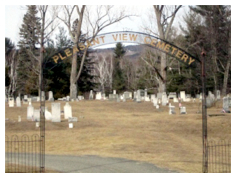
Pleasant View Cemetery (formerly the Hayes Cemetery)
The Pleasant View Cemetery is one of five cemeteries located in the Town of Wilmington, but is the most centrally located. Many of the memorial stones date to the early 1800's, with the earliest pioneer families, who for the most part have New England roots. For example, Amos Avery, the town's first blacksmith, and his family are buried here. Stephen Partridge, one of the first to die in the Battle of Plattsburgh in the War of 1812, is also buried here. Wilmington men and women gave their lives in other wars as well, including Lafayette Warren who died in Andersonville Prison during the American Civil War.
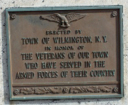
Veteran's Memorial Corner
Located at the intersection of Route 86, Bonnieview Road, and the start of Whiteface Mountain Veterans' Memorial Highway is a plaque dedicated to the veterans of all wars. The Whiteface Memorial Highway was originally built to honor the veterans of World War I. Later, it was rededicated to all veterans of all wars. Whiteface Mountain Veterans' Memorial Highway allows anyone, regardless of physical ability, to attain the top of one of New York State's highest peaks. The project began in 1929 with Governor Franklin D. Roosevelt turning over the first spade of earth. The highway was officially opened on July 20, 1935. The dedication is entitled, "Lest We Forget".
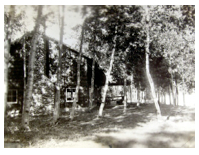
The Owaissa Club , now the Lake Everest Park and Wilmington Town Beach
(NOTE:The building in the photo on the left no longer exists.) Organized in 1920, the Owaissa Club, Inc. was built and maintained as a clean, safe place for recreation for young people. A small membership fee was charged for residents and guests. Equipment included row boats, canoes, a motion picture machine, a player piano with hundreds of rolls, a phonograph with many records, indoor and outside fireplaces, a kitchen and a well-stocked reading room.
Eventually, the Owaissa Club building and surrounding area was replaced by the Lake Everest Park and the Wilmington Town Beach. Most recently, a new pavilion, rest rooms and boat launch have been put in place.
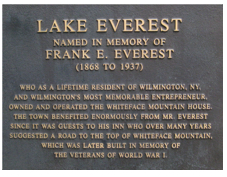
Frank E. Everest Memorial
Frank Everest was an entrepreneur and promoter of Wilmington as a resort community and was instrumental in encouraging the idea of constructing a road up Whiteface Mountain. He was the owner and proprietor of the famed Whiteface Mountain House (hotel) and a well-known businessman. He encouraged the "electrification" of Wilmington, first bringing electricity to this small rural town by constructing a small hydro-power plant at the Wilmington Dam. Lake Everest is named in his memory.
Wilmington Airport / Walter Prager Ski Shop (now the North Pole Gift Shop & Campgrounds)
In June of 1928, construction of the Wilmington Airport was completed on the land now occupied by the North Pole Campground. With land donated and developed by Frank E. Everest, proprietor of the Whiteface Mountain House, it had 2 runways, one 1600 feet long into the prevailing winds and the other 1300 feet long into the crosswinds. In 1929, Christie Mathewson, Jr., son of the famous New York Giant pitcher in the early days of professional baseball, ran airplane sight-seeing tours from here. By the 1940's, as airplanes grew in size and needs for larger municipal airports increased, the airport eventually was no longer adequate, the buildings were disbanded or moved and other businesses took over the land.
One of the businesses that was built on part of the former Wilmington Airport land was the ski shop, Maison de Ski, owned and operated by Walter Prager. Prager was a Swiss immigrant and veteran of the famed 10th Mountain Division, having seen combat in Italy. He was a downhill ski racer and world champion skier. He was also a ski instructor at Dartmouth, a coach of the 1948 Olympic Ski Team and developed the women's downhill ski race course for the Olympics at Squaw Valley. In addition to running this ski shop on Route 86, he also operated the ski shop at the Lodge at Paleface Ski Center on the mountains overlooking nearby Jay, NY.
The Carousel Restaurant & Strawberry Roan Gift Shop (now the Candyman & Ausable River Fly Shop)
(Photo ca. 1949)
The Carousel Restaurant and Strawberry Roan Gift Shop were designed by artist Arto Monaco, who also designed the buildings at Santa's Workshop on Whiteface Highway. Their prime location made them a popular tourist spot. Later the restaurant became the Gateway Restaurant and the smaller gift shop has seen many businesses, including a real estate office, and now the Ausable River Fly Shop. ]
Olney Hotel Site
(NOTE: The building in the photo no longer exists.)
Located on the west side of the West Branch of the Ausable River, Hotel Olney ranked among the best in the North Country. It was first owned by Edwin Olney, a Civil War veteran, who established his hotel business ca.1869. Edwin's son Oscar Olney took over the business and was proprietor well into the 20th century. The hotel had lawn tennis and croquet grounds, as well as a piano and organ provided for guests. Cottages were also added as an option for guests, one of which can still be see next to the river on the same property, and another is now a tanning salon, exercise facility, UPS Mail drop, gift shop and coffee shop. In later years, as other owners took over the business, the hotel was variously named The Whiteface Club, Riverside, The Homestead, The Wilmington Inn, The Cloudspin Inn, The Falcon's Nest, and lastly re-named The Wilmington Inn. The building burned in the 1980's, and has been replaced by a private residence.
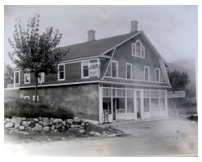
Bouchard or Marshall Block (now the Lake Everest Diner)
Built by George "Grubby" Marshall in the 1920's, it had a restaurant on the first floor and apartments above. There was also an electrical and contracting business, "Marshall & Brimley" on the basement level. After the Whiteface Memorial Highway & new stone bridge were built in the 1930's, the building had to be raised to match the level of the road. Since the first restaurant, the business on the main floor has been the "Whiteface Market", the "Ausable River Sport Shop", and now "The Lake Everest Diner".
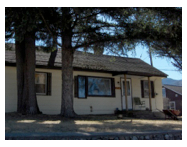
Everest Cabin
This private home was once the residence of Frank E. Everest, well-known entrepreneur and businessman and the owner & proprietor of the Whiteface Mountain House, a well-known hotel which had been located on adjoining property.
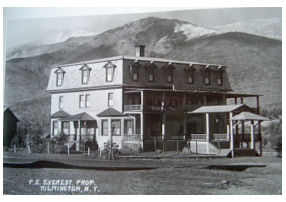
Whiteface Mountain House (hotel, now Wilson Farms store)
(Photo ca. 1900) The Whiteface Mountain House (hotel) had been the cornerstone of the tourist trade in Wilmington spanning two different centuries. In an 1871 descriptive guide to the Adirondacks, the Whiteface Mountain House, owned by Weston and Ayer, was featured. It offered "package deals", allowing passengers going by stagecoach through to the Saranac Lakes, to "stop at the Whiteface Mountain House and have an opportunity of ascending the mountain, and be carried for the same price as if they went through direct." Also offered were , "boats will be provided on the river, to accommodate the guests of the House; also necessary attendants, at all times", and, "guides, carriages and good saddle horses, for ascending the mountain..." In a 1916 travel guide, with Frank E. Everest now as proprietor, this "popular house" offered "large piazzas, light and airy rooms, hammocks, swings, and sand gardens for children". 75 rooms were available at the time. Terms were $10 to $14 per week. In its peak years the Whiteface Mountain House employed 30 persons and served 600 meals on a busy summer Sunday. In the 1920's owner Frank Everest financed a waterwheel generator built at the old wooden dam, to electrify the hotel and bring it up the standards and expectations of its guest. The after affect was that the whole town became "electrified". Whiteface Mountain House was the centerpiece of Wilmington until the death of Frank Everest in 1937.
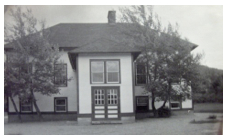
Wilmington Village School Site (building no longer in existence), now Wilmington Town Hall & Community Center
(Photo ca. 1950)
In the 19th century, Wilmington originally had 8 different one-room schools, scattered about the town, later reduced to 6 school districts. One of the schools was called the "Village School" District #3, located in the center of the town. Originally it was located next to the current Nazarene Church. A new school was built on that same spot in 1911, but the heating system was flawed and in 1917 the 6 year-old school burned down. All children were evacuated safely, but the school and contents were a complete loss. The property was sold at auction and the school was moved to the location of the present Wilmington Town Hall & Community Center, land purchased from Albert Wilkins for $200. The Wilmington Village School (in the photo) served the Wilmington village school children until the district, along with 2 of the other Wilmington District Schools merged with the Lake Placid School District in the late 1960's, and the building was torn down to make way for the current Wilmington Town Hall & Community Center.
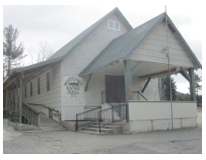
Help Each Other Club/ Old Town Hall /Northern Lights School (now the Whiteface Range Hall)
The current Whiteface Range Hall was originally built as the "Help Each Other Club" in the late 1920's as a place where townspeople could gather for social activities. The organization was actually a front for the KKK, not so much against African Americans, but anti-Catholic, following the widespread Adirondack/Northern New York anti-Catholic movement at the time. It has also been reported that the "elders" would keep people "morally straight". The hall served as a place for meetings, square dances, harvest dinners and Minstrel shows. In the 1940's the building served as an American Legion Post, again serving as a meeting place for the community. In the late 1960's the building became the Wilmington Town Hall. The building also served as the place where the re-organized Wilmington Library took form in 1983. In the mid 1990's the Town Hall moved into the Wilmington Community Center. A few years later, the building became the Northern Lights School. When the school moved to Saranac Lake, Roy and Becky Holzer purchased the building and the building was renovated as the Whiteface Range Hall, a place anyone can rent for gatherings.
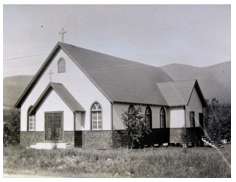
St. Margaret's Roman Catholic Church
(Photo ca. early 1930's))
The parish of St. Margaret's Church was incorporated in August 1926, with funding backed by Jon J. O'Leary and George Smith. In the fall of that same year, the church was destroyed by a great wind, which literally knocked it off of its foundation. Until the church could be rebuilt and more money raised, the church members met for a while at the home of John J. O'Leary. With the anti-Catholic wave of sentiment in the area, the local KKK held a cross-burning on John J. O'Leary's property. Contemplated legal action was considered against those participating, and the KKK disbanded, with the church resuming normal operations. Since being rebuilt, the church has enjoyed continuous service to both the local and tourist community.
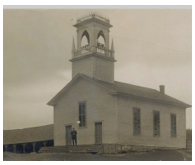
Congregational Church , now the Nazarene
(Photo ca. 1980's)
The Congregational Church was built in about 1834. The horse sheds to the left in the photo were built in 1897 at a cost of $360.00. The church suspended operations in 1907. The Nazarene Church in Wilmington had its beginnings in 1905 under the leadership of Daniel Haselton. The official church was established in 1921, with 14 members. The first pastor, Rev. T.F. Harrington, serving 1921-1923, had no car, so visited his parishioners by walking home to home. He gained reputations as the fastest man on foot in the town of Wilmington! The Nazarene Church was incorporated in 1932, taking over ownership of the old Congregational Church building. In the early days of barnstorming, the church took a hit. Ca. 1927, a barnstormer who was giving airplane rides (from an airport located at the current North Pole campground), crashed into the side of the Nazarene Church, falling to the ground upside down. The 2 passengers and the pilot were injured. Frank Hewitt was one of the passengers who had facial wounds. The other was Jim Lawrence who had a smashed leg. Repairs were made and a new steeple constructed.
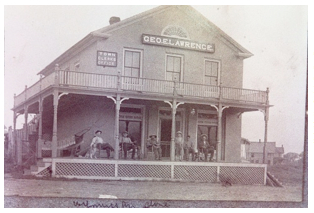
Site of the George Lawrence Store/ Cooper Store/Hazel & Bill's Restaurant
(now an empty parking lot on the corner)
(Photo ca. 1900)
Originally a general store owned by the Westons, as shown on an 1876 map, the George Lawrence Store served as a gathering and resting place (note the hammock on the porch!) as well as a general store. The Town Clerk had an office on the second floor. The store burned in the early 1900's and was rebuilt as Cooper's Store, owned by Bert & Pliny Cooper. On cold days, since it was not far from the village school, schoolchildren would wait here for their parents to pick them up. Later, Cooper's Store became Hazel & Bill's Restaurant, which burned down in the 1970's.
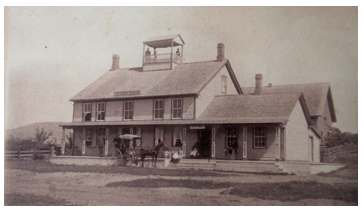
Storr's House (hotel / boarding house), currently a private home
The Storr's House (hotel/boardinghouse) is likely the oldest house in Wilmington, built by pioneer Reuben Sanford ca. 1810. The addition on the right was added ca. 1812. It was used as an inn, a stage stop and a store. Note the widow's watch on the top of the building, a feature usually found on New England homes. In this photo, there is a gentleman on the front porch in a wheelchair, Mr. Ira Storrs, a Civil War veteran. There is also some oral history and speculation that this was a house on the Underground Railroad, a stop for runaway slaves on their way to Plattsburgh, then on to Canada, but to date there is no substantiation of these stories.
(Photo Post-Civil War)
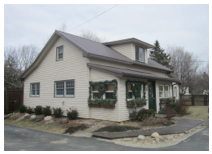
Amos Avery's Blacksmith Shop, now a private home
When Amos Avery first arrived in Wilmington in 1822 from Burlington, VT, the area was just the beginnings of a village with a few mills and an iron forge. He set up a blacksmith shop near the center of the village. He and a companion used to sleep in the shop and on winter mornings they would find their pillows and bedclothes covered with snow which had drifted through the gaps in the walls.
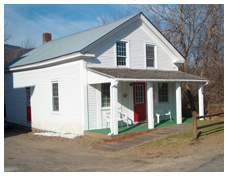
Reuben Sanford Building (formerly a store/ Post Office/Town Hall/ American Legion Building)
The current "Reuben Sanford Building" is currently owned by the Whiteface Community United Methodist Church, serving as its office and the local Ecumenical Food Pantry. Built in about 1835, it first served as a store and post office, then became the Wilmington Town Hall, and finally was the American Legion Hall, just prior to its purchase by the Methodist Church. Why is it now called the "Reuben Sanford Building?" In 1803, at age 23, Reuben Sanford and his wife Polly had moved westward from Woodbury, Connecticut to settle in the part of the Town of Jay now known as Wilmington. He built a forge, a blacksmith shop and a saw mill. He also established an extensive iron industry in Wilmington known as the Sanford Iron Works, and built a potash factory which used the ashes from local farmers to make soap. He was also the first innkeeper in the village and sponsored the construction of the village schoolhouse. During the War of 1812, he was commissioned as Major, leading 4 companies of militia from the Towns of Jay, Keene and current Wilmington at the Battle of Plattsburgh. He became a war hero in that battle when he kept the British from crossing a Plattsburgh bridge by cutting the stringers of the bridge while under heavy fire, one of the volleys actually striking the axe he was using to chop the bridge timbers. After the war, he represented the district in the New York State Assembly from 1814-1817, was a delegate to the New York State Constitutional Convention of 1821 and was a member of the State Senate for four years, being elected in 1828. He was instrumental in establishing the Town of Wilmington as a separate entity from the Town of Jay in 1822 and became its first postmaster. He served as Town Supervisor for two terms. He was the primary force behind the construction of Wilmington Methodist Church in 1833-1834. Soon after the church was completed he erected the first store. Reuben Sanford was the mightiest pioneer in the Town of Wilmington and one of the most prominent men in Northern New York.
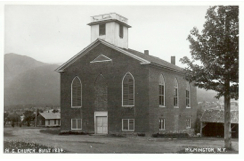
Whiteface Community United Methodist Church (built 1834)
In about 1800, in what was then a wilderness dotted with a few farms, there was a need for the people here in this (now Wilmington) portion of the Town of Jay to bring a semblance of civilization into their lives. Local townspeople sought the promise of social responsibility and organization through a system of "Methodist Church societies". There was a small nucleus of people in Wilmington who began a Methodist Society - Mr. and Mrs. Reuben Partridge and Mr. and Mrs. Reuben Sanford. They began by meeting at each other's homes with prayer and Bible study. In 1816 the Plattsburg Circuit sent Eli Barnett and Jeremiah McDaniels as the first preachers. In between monthly or bi-monthly visits from circuit riding preachers, laypeople continued with religious study and lay-preaching. Although the group struggled to keep the church alive, it slowly grew enough so that meetings had to be held at the local village schoolhouse located next to the current Nazarene Church. It was not until 1833 that Reuben Sanford initiated the actual construction of the Wilmington Methodist Episcopal Church, with the final completion in 1834.
(Photo ca. 1900) (Note horse & carriage barns in the back)
Industrial Site of the 1800's
You are now standing between the Methodist Church and the Visitor's Bureau facing the Riverside Thrift Shop. Below is an 1876 map of Wilmington's industrial center, placing you in the same vantage point. One of the sawmills to your left had 40 saws! The charcoal kilns (making charcoal from local hardwoods) were spewing smoke and the saws and mills iron forge, starch factory and shops were noisy - hardly the Wilmington we know today! We hope you have enjoyed your tour through time in Wilmington, from agricultural/industrial center to tourist destination. Come visit us again!
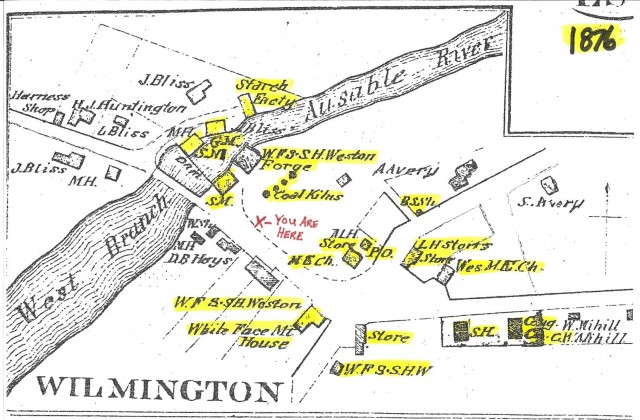
KEY:
Starch Facty = Starch Factory
SH = School House
GM = Grist Mill Cong.
Ch.= Congregational Church
SM = Saw Mill Wes.
ME.Ch.= Wesleyan Methodist Church
WF & SHW = WF &SH Weston
BSSh = Blacksmith Shop
ME Ch.= Methodist Episcopal Church
PO = Post Office

